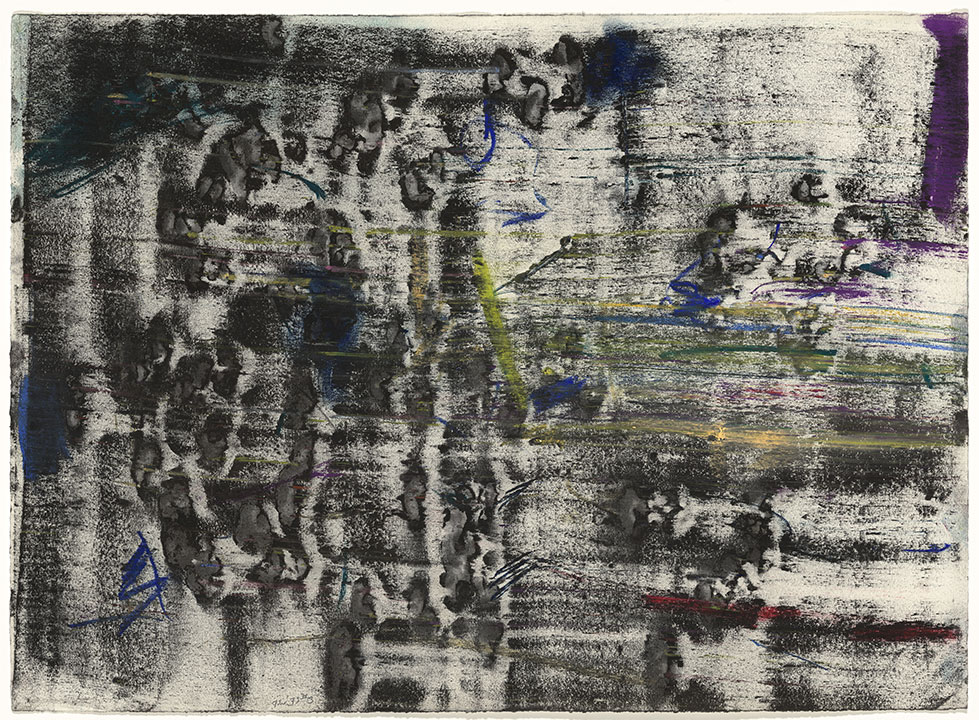Acquisition: Jack Whitten

Jack Whitten
Cut Acrylic Series #3, 1973
pastel and powdered pigment on wove paper
sheet: 47.5 x 65.8 cm (18 11/16 x 25 7/8 in.)
National Gallery of Art, Washington
Gift of Funds from Agnes Gund
2023.24.1
© 2023 Jack Whitten
One of the most influential abstract and conceptual artists of his generation, Jack Whitten (1939–2018) is best known for his innovative approaches to applying paint to canvas that result in fissured surfaces and unusual terrains. Whitten’s style has been described as bridging gestural abstraction and process art. The National Gallery of Art has acquired three extraordinary drawings by Whitten that provide insight into his artistic interests and demonstrate the important place of drawing within his career.
Initially associated with the abstract expressionist painters active in New York City in the early 1960s, Whitten gradually focused on experimenting with process and technique, an approach that came to define his distinctive practice. In place of a brush, Whitten used squeegees, Afro picks, combs, and tools he made to apply paint to canvas. Among his signature inventions was a collage-like technique that he developed in the early 1970s. He cut small cubes, or tesserae, from slabs of acrylic paint and then arranged and adhered them to catch and reflect light on his canvases.
Drawing was a vital component of Whitten’s artistic endeavor. He was fascinated by the responsiveness of different types of paper to various media, and he welcomed the incidental effects that the immediate environment (temperature, humidity, etc.) could create.
King’s Garden #14 (1968), made during the year of Dr. Martin Luther King’s assassination, is typical of Whitten’s earlier work, with figurative elements dispersed within an abstracted landscape. Inspired by Dr. King and the civil rights movement, Whitten’s participation in the nonviolent student demonstrations held across the country in the spring of 1960 had a profound effect on his worldview. Drawn with sumi ink, the washes of black ink in King’s Garden #14 seep into highly absorbent rice paper, creating soft-edged contours that suggest trees, foliage, and gently rounded hills on the horizon. Passages of pale tan washes define seemingly disembodied heads with facial features executed in flourishes of fine lines in pen and ink. Among the unusual feature of this drawing are numerous areas where long paper fibers have been teased out, flared, or added to the paper surface. Appearing as fuzzy ghost-like forms within passages of black ink wash, this textural effect contributes to the composition’s dream-like aura, enhancing the spectral presence of the various faces that float above and emerge from the landscape.
Cut Acrylic Series #3 (1973) was created when Whitten was fully committed to experimenting with the conceptual possibilities of paint and pigment. He used various tools to drop and smear powdered black pigment across the surface, incorporating the paper’s texture to emphasize the interaction between the drawing material and the support. Against this predominantly black field, Whitten selectively added marks in brightly colored pastels to call attention to the drawing’s flat surface and to make the dark underlayer appear to recede in space. The seductive tactility of the drawing, with its variety of textural, gestural, mechanical, and incidental mark-making, exemplifies Whitten’s navigation of process-based and gestural abstraction.
Radiator Drawing #5 (2010) is part of a series of drawings that was inspired by Whitten’s fascination with the grille design of his old car’s radiator. He transcribed the design by placing a sheet of rice paper over the radiator grille and rubbing it with graphite. The resulting composition has an ethereal quality created by the uneven transfer of the grille texture. The addition of repeated circles of different sizes and diagonal lines suggest planetary pathways or other cosmological connections. Whitten also emphasized the physicality of the drawing: vertical and slightly angled wound-like slits in areas of heavily applied graphite disrupt the surface of the thin rice paper.
Contact Information
General Information
For additional press information please call or send inquiries to:
Department of Communications
National Gallery of Art
2000 South Club Drive
Landover, MD 20785
phone: (202) 842-6353
e-mail: [email protected]
Chief of Communications
Anabeth Guthrie
phone: (202) 842-6804
e-mail: [email protected]
Newsletters
The National Gallery also offers a broad range of newsletters for various interests. Follow this link to view the complete list.